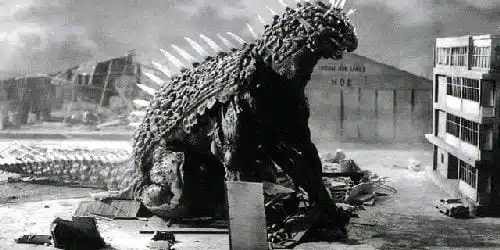
Alternative titles: Night of the Iguana-Like Thing
POSITIVES:
Another great Toho monster, this one with spikes and wings (sort of).
Better-than-usual model work and effects.
Atmospheric, King Kong-esque “lost valley” sequence sets things up well.
Pretty good acting.
NEGATIVES:
Monster bears more than a passing resemblence to Gojira.
Annoying martial music during battle scenes.
Varan’s unique quality—he can fly!—is grossly underutilized.
SYNOPSIS: Scientists hunting butterflies in the isolated region known as “the Tibet of Japan” discover more than they expect, in the form of sulky villagers and also, um, death. More scientists go snooping around to find out what happened to them—including Dr. Kenji, reporter Yuriko (a sister of one of the dead men) and chubby comic relief Horiguchi. The locals believe this “Baradagi” character had something to do with the deaths, but are vague on the details.

The three explorers walk through the woods for a while, before something awful happens: they meet a little kid in a Japanese monster movie. Fortunately, the kid, Gen, does nothing but lead them to his village, where the priest is praying to Baradagi, and then he (the kid, not the priest) runs off ito the jungle after his dog. This is bad idea #1. Or #2, if you count the explorers laughing at the priest, while telling him that they’re too smart to believe in Baradagi.
Bad idea #3 quickly follows, as the explorers rush into the woods after Gen, and then—#4, if anyone’s keeping track—convince the villagers to go with them and help look. They find Gen all right, but they also find an enormous Godzilla-clone with long glowing spikes growing out of his head and back. This is Baradagi, who has become annoyed with these pesky humans and decides to take swift action. Baradagi makes one of the most memorable entrances in Toho-monster history. Cue mayhem.
Said mayhem catches the eye of the authorities in Tokyo, who decide they must snuff Baradagi—now called Varan, go figure—with all haste. Predictably, they fail to do anything of the sort. Partly this is due to inadequate firepower, and partly it’s because nobody counted on Varan’s being able to—get ready for it—fly. Meanwhile, Yuriko and Kenji hide out in a cave, which seems like a good idea at first. But it turns out that hiding in a cave is about as useful as sitting in a small fishing boat in the open ocean. Speaking of which…
Hey, the only thing that go could worse at this point would be if the monster attacked, um, Tokyo or something.
Best line of dialogue: “We have ample evidence to assume that Varan is a Varanapode.”
What gets unbelievably trashed: Two guys and their Jeep; a priest; a vilage; a rocket-launching truck; a fishing boat and three fishermen; an airplane; a truck; a bit of waterfront; another plane and a bus; some prime real estate; a critter that, if I hadn’t seen it for myself, I’d have found unbelievable.
What gets even more unbelievably saved: The big city—this time.
Moral of the story: Pay attention to the locals.
Party game: Play “Monsters Ball.” Players rank the relative awesomeness of various Japanese monsters–Godzilla, Mothra, Ghidorah, the Smog Monster, the robot armadillo from The Mysterians and so forth. Most persuasive argument wins. Optional: open up the debate to non-Toho monsters like Gamera, King Kong, Hannibal Lecter, etc.
Did you know? Director Ishiro Honda directed the original Gojira (1954) for Toho, kicking off Japan’s monster-on-a-rampage genre, and made his name with numerous monster/sci-fi/lots-of-things-exploding flicks, including sequel Godzilla Raids Again (1955), Rodan (1956), The Mysterians (1959), Mothra (1961), Matango: Attack of the Mushroom People (1963), Ghidorah, the Three-Headed Monster (1964), and countless others. He was a friend of landmark director Akira Kurosawa and worked as assistant director on several of his movies, including 1985’s epic Ran. Kurosawa delivered the eulogy at Honda’s funeral in 1993.
Somehow their careers survived: Kozo Nomura (Kenji) would appear in 1964’s Godzilla va. Mothra as well as Ghidorah, the Three-Headed Monster, while Ayumi Sonoda (Yuriko) who appeared in The H-Man (1958), would enjoy a more modest career. Fumito Matsuo (Horguchi)’s future credits would include Age of the Gods (1959) and Man Against Man (1960).

BOTTOM LINE: Overlooked next to its better-known brethren, it’s a diverting and well-made monster-on-the-loose.
NEXT WEEK: The Fly (1958)
